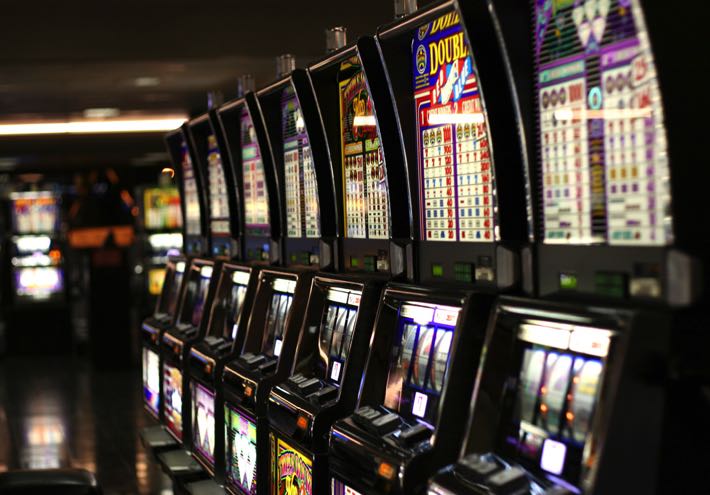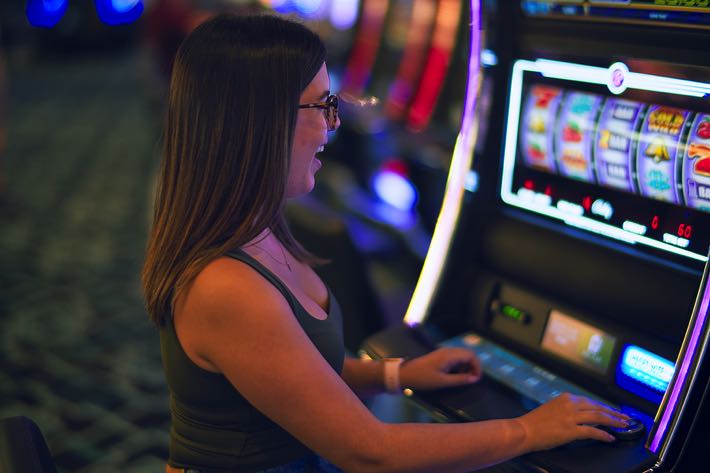
We all like to have a laugh with our friends, doubtless often heading to poker rooms or casinos with them for want of something better to do on a Friday night. How many of us have asked a friend for advice when playing blackjack, or told them to blow on the dice before throwing them in a game of craps? That’s something that you might want to think twice about after heading the story of Jan Flato, however.
He was stood at the Double Top Dollar slot machine in the Seminole Hard Rock Hotel & Casino with his friend Marina Medvedeva Navarro, feeding dollars into it so that he could play. It was Navarro that pushed the button when the lights lit up and the pay line showed a $100,000 win, so casino managers decided that that mean that it was her that was the winner of the jackpot amount. Who was the rightful winner of the cash?
What the Rules Say
Whilst both Navarro and Flato have different versions of what happened to tell, as we’ll come to shortly, the important point in the whole debate is what the Seminole tribe that ran the casino had to say about the matter. They were quick to point out that gambler information is kept confidential, but their spokesperson, Gary Bitner, said that the casino was following rules set down before gambling was even in Florida:
The pusher of the button is the winner of the loot.
That opinion was confirmed by Frank Legato, who was the Editor of a magazine entitled Global Gaming Business and had testified in numerous slot cases as a legal expert. He said, “Pressing the spin button is really the act of making the wager.” Flato said that lawyers appeared to agree, with no one being willing to take on his case. He declared, “That jackpot money is long gone.”
What the Two People Involved Say Happened

Perhaps somewhat unsurprisingly, the two people involved in the case have differing stories about what happened before the jackpot hit and the $100,000 was won. Jan Flato moved from Las Vegas to Aventura about a year before the event, doing so in order to take care of his mother who was eighty-eight. He first met Marina Medvedeva Navarro, who was thirty-five at the time of the incident, at the high-roller room at Gulfstream Park back in 2015.
His Version
His story goes that he was putting notes into the Double Top Dollar slot machine, which requires a payment amount of $50 per spin in order to hit the jackpot. He’d met up with Navarro at the centre bar in the casino, moving to the Hard Rock high-roller room. Having played slots together countless times before, he didn’t think anything of feeding the notes into the machine so that Navarro could ‘push the button for good luck’.
Navarro’s story, of course, is completely different. She said that she had herself paid $400 into the machine, promising Flato a portion of the win when it hit. He declined to take it, believing that it should have been his in its entirety. Regardless of which version of events is true, the fact that she pressed the button meant that she won the money, taking $50,000 in cash and a cheque for the other $50,000.
Flato said, “I’ve played slots all over the country and never had a problem like that. Even the people handing out the money said, ‘This isn’t right.’” Quite whether the last part of that is true is a matter for debate, given the casino agreed to have armed security personnel watch Flato as Navarro made her way out of the venue with her loot. In the time that followed, he barely heard from his former friend, who simply text to ask, “Still hate me?”
Her Version
Navarro later decided to expand on her version of events, muddying the waters further. She doubled down on her assertion that it was her money that she was playing with and that it was never in question who would be taking the money home. She said that she had won $400 in one machine after playing it with $100 of her own money, then placed that money into the Double Top Dollar slot machine that eventually hit the jackpot.
According to Navarro, who worked as a mortgage broker in Hallandale Beach and lived with her husband in Aventura, she let Flato put his loyalty card into the machine so that he would get the associated perks. After hitting the jackpot, she said that they ‘yelled and screamed and hugged and were very happy’. A crowd gather as the casino officials looked back over the video, taking about twenty minutes to confirm what had happened.
Navarro said that Flato was already dividing the money up during this time, ‘going ballistic’ when officials came down to give her the money. Navarro said, “I said, ‘Just wait and let me figure this out, and when you calm down we’ll speak.’” It was in the wake of her leaving the casino that things turned truly sour, with Flato bombarding her with rude and insulting text messages and emails, including one that urged her to ‘go back to Russia’.
Flato didn’t deny sending such emails, but said that he did so because she’d ‘stolen $100,000 of my money’. Whilst refusing to apologise for the personal attacks, he did regret saying ‘mean things about her children’. When it came to the key point of who pushed the button, though, Navarro said that Flato knew whoever pushed it would get the jackpot and when they gambled together at Gulfstream Park he’d get her to put her fingers on top of his ‘for good luck’.
In the wake of the story going public, firstly thanks to Flato speaking on a gambling podcast about the issue but later when it ran in newspapers, Navarro said that she began to hear from ‘angry gamblers’ who had managed to get hold of her number. She said, “I never thought it would turn into such a disaster.” Flato, for his part, said that he went public in order to urge other gamblers to be aware of who was pushing the button of slot machines in casinos.
Disputes Over Gambling Winnings Aren’t All That Rare
Unsurprisingly, the case of Navarro and Flato isn’t the first time that people have disagreed over where gambling winnings should be paid. At the turn of the millennium, for example, a Texas woman and her friend were gambling in Las Vegas and won $1.9 million, which the Texas woman sued her long-time pal over. Ten years later and two sisters from Boston, who had a signed and notarised agreement to share winnings, went to court over a $500,000 lottery win.
Whether it be $1.1 million won in a casino on a cruise ship or $2.3 million that was awarded to slot players at a French casino, many of them have ended up in courts. That is why the general rule of thumb that the person that pushed the button is the one that gets to lay claim to the prize is often called upon by lawyers in such cases. Whilst it might seem confusing if someone else paid the money into the machine, the pressing of the button is the making of the bet.
The Similar Case in France
The case of the friends in France fighting it out in court over nearly £2 million in winnings bears striking similarities to the story of Flato and Navarro. Marie-Hélène Jarguel paid the €50 stake to play on the Magapot slot machine at Palavas-les-Flots Casino, near Montpellier. Her friend, Francis Sune, was the one who actually pushed the button after having previously ‘brought her luck’ when playing on the slots.
The pair were aiming to win the €2.2 million Megapot jackpot, which required three number sevens to be lined up in a row on the machine. It was lucky number thirteen as far as the jackpot was concerned, resulting in cheers of joy and Champagne for everyone. French casino rules state that one person has to be paid the winnings, so it was Miss Jarguel who left the venue with the cheque for the equivalent of £1.96 million.
Unlike in America, where the rule of thumb that the presser of the button wins the prize is commonly used, France had no such rule to turn to when Sune sued his friend for at least half of the winnings. On top of that, the rules of the casino were also vague on the matter. Sune felt that it was clear that he was owed some money, stating, “She could’ve bet 1,000 euros if she’d liked but without me she would have won nothing. On the Monday she phoned to tell me she’d give me something, but on the Friday she no longer knew me.”
Obviously the lawyer for Mr Sune felt his client was owed at least half, imploring the judge to dole out a ‘solomonesque ruling and split the winnings’. The legal team of Miss Jarguel, on the other hand, said that Sune wanting money for pushing the button when it was their client that had paid the stake money. They said, “It’s a bit like a secretary who typed up the manuscript of a best-selling writer asking for royalties.”
In the end, it was Mr Sune’s later who proved to be closer to the result. A court in the city of Montpellier decided that Marie-Hélène Jarguel’s payment of the stake money meant that she was entitled to most of the winnings, awarding her 80% of the €2 million jackpot. Sune, meanwhile, won the remaining 20% and the judges noted that there was no definition of what the winner is when it comes to slot machines.
Why the Button Pusher Gets a Claim

To many, it might seem odd that the person who pushes the button is entitled to the prize money rather than the one who put forward the stake in the first place. That being said, who should take the winnings of a scratch card that shows the jackpot if one person paid for it and another selected which one to buy? After all, if the selector had chosen a different card then it wouldn’t have been a winner.
It’s not an entirely dissimilar argument when it comes to the button pushing on a slot machine. Such machines are controlled by random number generators, which use any number of factors to decide when they will show a winning jackpot. Even a delay of just a few milliseconds before pushing the button can result in an entirely different outcome, such is the precision involved with RNGs and slot machines.
When such fine margins are involved, it’s little wonder that the person who pushes the button feels that they’re entitled to a large chunk of the prize money. It also explains why it’s crucial that agreements are put in place before heading to a casino. Friends and family have fallen out over much less than a couple of million, so ensuring that all parties know what will happen with any winnings is crucial for future harmony.